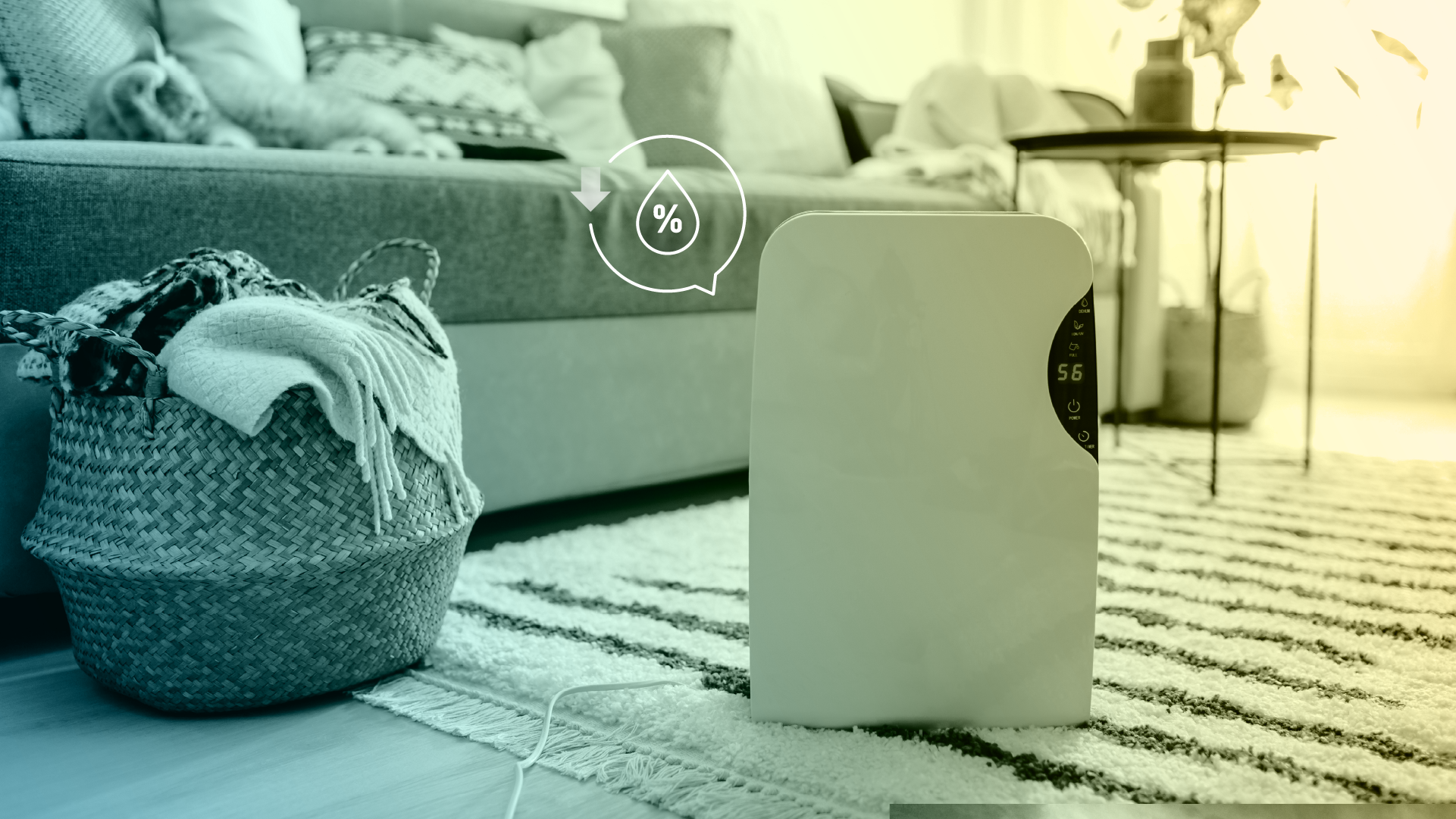15 Ways to Lower the Humidity in Your House
High indoor humidity levels can create an uncomfortable and potentially unhealthy living environment. It can make indoor spaces feel warmer, encourage mold growth and musty odors, and push your HVAC system to its limits. Fortunately, there are many simple, effective ways to reduce the moisture in the air and reclaim your home’s comfort. This article is your guide to decreasing humidity in your house, from identifying leaks to embracing cost-saving DIY solutions for enhancing indoor air quality, and why that’s important.
How to Lower Humidity Indoors
High indoor humidity levels can create an uncomfortable and potentially unhealthy living environment. Excess moisture in the air can lead to mold growth, musty odors, and compromised indoor air quality.
Here are some tips to help you maintain a comfortable and healthy home by managing and its lowering humidity levels.
1. Address Key Source Areas
Controlling humidity levels involves preventing moisture from entering and accumulating in your home. Start by addressing areas prone to dampness:
- Crawl space. If your home has a crawl space with a dirt floor, cover it with a vapor barrier such as polyethylene ground cover to keep soil moisture from entering your home. The soil should be dry, and there should be no standing water in the crawl space. Use fans for air circulation to expedite drying, especially if there’s excess moisture.
- Clothes dryer vents. Your dryer should vent directly outside. Incorrect venting can significantly increase indoor humidity and pose a fire hazard. Your dryer duct should be properly installed and unobstructed to expel humid air efficiently.
2. Run Exhaust Fans Indoors
Efficient use of exhaust and ventilation fans in these high-humidity areas is essential for removing excess moisture and maintaining good indoor air quality:
- Kitchens. Always turn on kitchen exhaust fans when cooking. This helps remove moisture generated from cooking and prevents it from spreading throughout the house.
- Bathrooms. Similarly, run bathroom fans during and after hot showers to expel humid air. Prolonged exposure to humidity levels above 55% can foster mold and bacteria growth.
- Small spaces. In addition to exhaust fans, consider installing ceiling fans or using portable ventilation fans to improve air circulation, especially in small spaces. This helps evenly distribute air and prevents pockets of humid air.
Regularly check and adjust these efforts based on changes in weather and indoor activities that may contribute to moisture levels.
3. Use a Dehumidifier
A dehumidifier is effective when indoor humidity levels consistently exceed 65%. Portable dehumidifiers are suitable for targeting specific areas or rooms with high humidity.
Consider investing in a whole-house dehumidifier system for more comprehensive control throughout your home. These systems integrate with your existing HVAC system and provide consistent humidity control, improving indoor air quality.
4. Run the AC
Air conditioners (ACs) are vital in regulating indoor humidity, especially in areas with high humidity levels. Air conditioners also remove excess moisture by cooling the indoor air, contributing to a healthier and more comfortable indoor climate. Air conditioners circulate and cool air, simultaneously reducing humidity levels by condensing water vapor into liquid and then draining it away.
It’s important to balance air conditioning with natural ventilation, and opening windows can reduce your reliance on your AC. But while it’s beneficial to open windows for fresh air, doing so on days with high humidity or warm air can counteract the dehumidifying effects of your air conditioner.
5. Grow Humidity-Absorbing Houseplants
Certain houseplants can naturally help reduce indoor humidity levels. Plants like Boston ferns are excellent at absorbing moisture from the air through their leaves. However, it’s important to be selective with houseplants, as some can release moisture into the air, potentially increasing humidity.
Here are a few plants known for their moisture-absorbing capabilities:
- Boston ferns. These plants are particularly effective at removing moisture and purifying air.
- Orchids and bromeliads. Adapted to rainforest environments, these plants absorb moisture through their leaves rather than their roots.
- Peace lilies. Not only do they absorb moisture, but they also purify the air.
By incorporating these plants into your home, you can reduce humidity levels while contributing to a healthier, more oxygen-rich environment. Research and choose plants that align with your local climate and indoor conditions for the best results.
6. Don’t Boil Water on Especially Humid Days
Boiling water can contribute to indoor humidity, as the steam released increases the moisture content in your home’s air. This effect is especially noticeable on particularly humid days. The steam can permeate your living space, exacerbating the humidity problem. To mitigate this, avoid activities that generate a significant amount of steam, like boiling water, during high humidity periods.
In addition to comfort, managing humidity also impacts energy efficiency. Lower humidity levels can make your home feel cooler, reducing the need for air conditioning and, consequently, your energy bills.
7. Clothes-Drying Tips
Laundry is an often-overlooked source of indoor humidity. The moisture from wet clothes, especially when hung to dry indoors, can significantly increase indoor humidity levels. This effect is amplified in poorly ventilated areas.
If possible, use a clothes dryer, which vents the moist air outside, reducing its impact on indoor humidity. Otherwise, hang clothes outside to dry when the weather permits. This prevents indoor humidity buildup while conserving energy.
8. Clean your AC filters
Air conditioners reduce humidity by pulling in outside air and removing moisture. However, their efficiency relies on clean filters. Clogged or dirty filters impede airflow and diminish the AC’s ability to dehumidify. Regularly cleaning and replacing AC filters maintains their optimal performance for humidity control.
Likewise, vented furnace filters require maintenance for similar reasons. Keeping these filters clean keeps your AC and furnace running smoothly, creating a more comfortable and less humid indoor environment.
9. Adjust Your Shower Routine
The daily habit of taking long, hot showers, while comforting, contributes significantly to the humidity levels in your home. These showers release considerable steam, increasing the air’s moisture levels.
To mitigate this, take shorter, cooler showers. Reducing the duration of your showers lessens the amount of steam and moisture released. Cooler showers produce less steam than hot showers, thus contributing less to indoor humidity.
Low-flow showerheads can further reduce your showers’ humidity impacts by limiting the water flow and, consequently, the steam produced.
10. Replace Carpet
Carpets, often valued for their aesthetic and comfort, can also play an unexpected role in your home’s humidity levels. They tend to retain moisture, which can contribute to higher indoor humidity.
If you’ve tried other humidity control methods without success, consider alternative flooring options that don’t retain moisture, such as hardwood, laminate, or tile. If that’s not possible, clean the carpet regularly, keep it dry, and replace it as needed to prevent moisture buildup.
11. Maintain Gutters
Proper gutter maintenance is essential in managing your home’s humidity levels. Clogged or damaged gutters can lead to water accumulation around the foundation of your house, increasing the risk of flooding, basement dampness, and elevated indoor humidity. Regularly cleaning your gutters to keep them free from blockages can prevent water infiltration into your home.
12. Save With DIY Solutions
Several DIY methods to reduce humidity in specific areas of your home don’t have to cost an arm and a leg. One effective method is using rock salt, a natural dehumidifier. Placing rock salt in a bucket or tray in damp areas can help absorb excess moisture from the air. This is a cost-effective and eco-friendly approach to managing small-scale humidity issues.
13. Adjust Your Thermostat
Using your thermostat wisely can contribute to controlling humidity levels. In warmer months, setting your thermostat to a slightly higher temperature can reduce the frequency of the air conditioner cycling on and off, which can maintain consistent indoor humidity levels. Smart thermostats can be particularly useful, as they can be programmed to optimize indoor climate control.
14. Fix Water Leaks Promptly
Water leaks, no matter how small, can also contribute to indoor humidity. Regularly inspect your home for leaks in pipes, roofs, and windows. Quickly repairing these leaks can prevent excess moisture from seeping into your home and keep humidity levels in check.
15. Use a Hygrometer
A hygrometer measures the level of humidity in the air, making this inexpensive device extremely helpful. It lets you take timely action to adjust humidity, whether by turning on a dehumidifier or air conditioner or implementing other humidity-reducing measures we’ve covered here.
Benefits of lower humidity in the home
Lowering the humidity in your home can make it more comfortable and also keep your house in tip-top shape. Here’s how:
Better Smell
Ever notice how some odors just stick around, no matter how much you air out your place? High humidity could be the culprit. It creates a breeding ground for musty-smelling mold and mildew. Clear out that excess moisture and bring a fresh smell to your home.
Decreased Allergy Symptoms
Humidity might be to blame if you’re constantly sneezing or dealing with a stuffy nose at home. It’s like a welcome mat for dust mites and mildew — big-time allergy triggers. This is especially concerning for kids, who can be more prone to asthma in these conditions. Keeping your place dry, particularly during damp seasons, can help keep allergens at bay.
Structural Health
It’s not just about your comfort; your house can suffer from too much humidity, too. Moisture can cause wood to rot or warp, and it can also mess with your drywall. High humidity can even allow mold to grow in hidden cracks.
Healthy humidity levels can help your home last longer and save you some serious repair costs. Managing your home’s humidity keeps you healthier and makes your home a fresher, sturdier place to live.
Lower Humidity and Energy Costs with Payless Power
Now that we’ve explored the ins and outs of lowering humidity in your home, you’re well-equipped to make some changes. Whether that means getting a dehumidifier, taking shorter showers, or being mindful about when to boil water, every little bit helps create a more comfortable and healthier living space. It’s not just about immediate comfort; these steps can lead to long-term benefits for your health and home.
And speaking of making smart choices for your home, why not switch to a more cost-effective electricity plan? Payless Power, a leading pay-as-you-go electric company, offers some of the best rates in Texas. Their flexible traditional and prepaid plans are designed to fit your lifestyle and budget, making it easier for you to manage your home’s energy needs efficiently.
Ready to make a change and save on your electricity bills? Check out Payless Power and see how much you could save. Explore your options and find the best plan for your needs. Lowering your home’s humidity and your energy bills — now that’s a breath of fresh air!
What our customers are saying
See why our power customers say we're the best electricity provider in Texas!
I was worried about getting electricity for my home through a prepaid company. I was calling around to see different rates then going through all the hassle of credit checks while dropping points each…
I have been with this company for several years and have been very happy since. Even when I moved, they made my usually stressful situation very easy and carefree. I recommend them to everyone that I…
I have enjoyed the service for 2 years now. In the beginning this service was planned to be temporary but with the service being so effective for me i decided to keep it for the long haul. I’m a happy customer.










